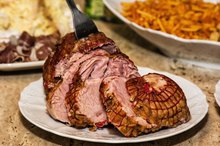How to Bake a Beef Heart
Bake beef heart when you are feeling adventurous. Beef hearts are large, weighing about 2 lbs. They have a gamey taste similar to kidney meat, but milder. Beef hearts are frequently stewed, seared or baked. A 3-oz. serving of beef heart is a good source of protein, vitamin B12, iron, niacin zinc and phosphorous.
Wash the beef heart and remove the inner heart strings.
How to Cook a Turkey Heart
Learn More
Melt 2 tbsp. of butter in a saucepan. Saute the shallots and mushrooms until they soften. Mix in the breadcrumbs. Saute for one more minute while stirring to coat the breadcrumbs with the butter mixture. Season the stuffing with salt and pepper.
Fill the beef heart with the stuffing. Close the beef heart by wrapping it with butcher's twine.
Vitamins for Palpitations
Learn More
Rub the beef heart exterior with the butter, and season it with salt and pepper. Carefully dredge the beef heart with the flour on both sides.
Place the rest of the vegetables in the baking dish, and place the beef heart on top of the bed of vegetables. Add approximately 2 cups of water to the baking dish -- enough water to cover the vegetables.
Bake the beef heart in the oven for an hour 2. Cover it with the juices from the baking dish every 15 minutes, using the basting bulb.
Remove the beef heart from the oven when the outside is brown and cooked all the way through.
Tips
Make gravy with the leftover basting fluid by adding 1 tbsp. of flour and heating the fluid while whisking until it thickens.
Related Articles
References
- Serious Eats; The Nasty Bits: Beef Heart, 4 Ways; Chichi Wang; March 2010
- Hugs.org: Baked Beef Heart Recipe
- Beef, ground, 85% lean meat / 15% fat, crumbles, cooked, pan-browned. FoodData Central. U.S. Department of Agriculture. Published April 1, 2019.
- US Department of Agriculture. MyPlate: Nutrients and health benefits.
- Clifford J, Curely J. Water-soluble vitamins: B-complex and vitamin C. Colorado State University Extension. Updated December 2019.
- National Institutes of Health Office of Dietary Supplements. Iron: Fact sheet for health professionals. Updated February 28, 2020.
- American College of Allergy, Asthma and Immunology. Meat allergy. Updated May 8, 2019.
- Song M, Garrett WS, Chan AT. Nutrients, foods, and colorectal cancer prevention. Gastroenterology. 2015;148(6):1244-60.e16. doi:10.1053/j.gastro.2014.12.035
- Wolk A. Potential health hazards of eating red meat. J Intern Med. 2017;281(2):106-122. doi:10.1111/joim.12543
- Daley CA, Abbott A, Doyle PS, Nader GA, Larson S. A review of fatty acid profiles and antioxidant content in grass-fed and grain-fed beef. Nutr J. 2010;9:10. doi:10.1186/1475-2891-9-10
Writer Bio
Kristin Dorman has been writing since 1999 and has had work featured in "The Stylus," the University of Maryland's literary journal. She is a certified yoga instructor and teaches a "Yoga for Runners" course through community education. Dorman holds a Bachelor of Arts in studio art and art history from the University of Maryland, where she graduated with university and departmental honors.









